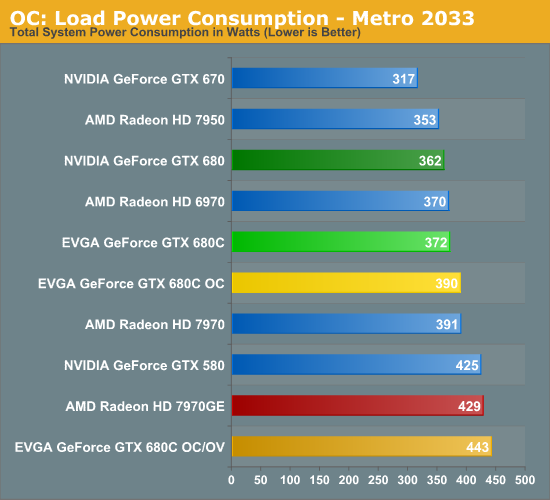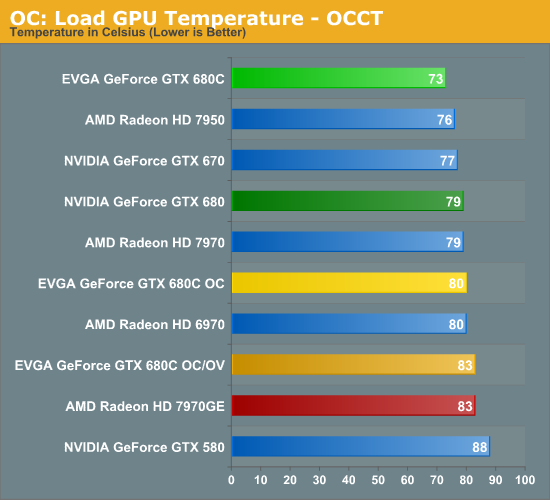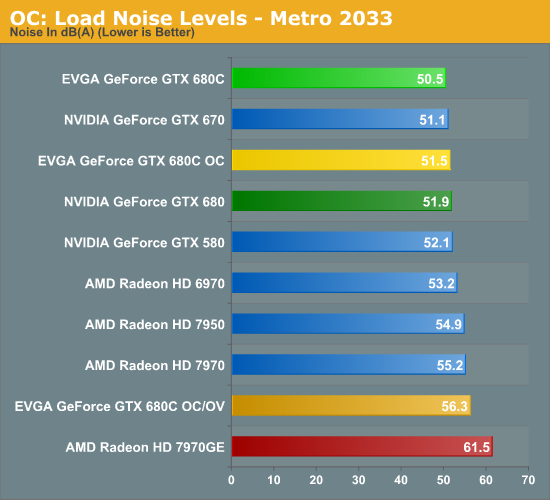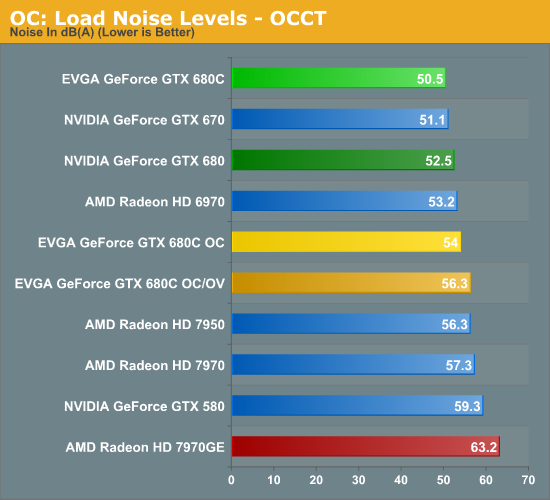EVGA GeForce GTX 680 Classified Review: Pushing GTX 680 To Its Peak
by Ryan Smith on July 20, 2012 12:00 PM ESTOverclocked: Power, Temperature, & Noise
So far our look at the stock performance of the GTX 680 Classified has been more obligatory than critical. The GTX 680 Classified is first and foremost an overclocking card, and while EVGA ships it with a decent factory overclock it’s the end-user overclock that is going to make the GTX 680 Classified stand apart from the crowd.
So how did the GTX 680 Classified fare? As always, we’re going to break our results down into two categories. We’ve overclocked our sample both with and without overvolting it, to get an idea of just how much more headroom is left in the GK104 GPU at stock, and how much more headroom is unlocked through overvolting.
| EVGA GTX 680 Classified Overclocking | |||||
| Stock | OC | OC + OV | |||
| Core Clock | 1111MHz | 1211MHz | 1287MHz | ||
| Max Boost Clock | 1201MHz | 1301MHz | 1377MHz | ||
| Memory Clock | 6GHz | 6.4GHz | 6.5GHz | ||
| Max Boost Voltage | 1.175v | 1.175v | 1.275v | ||
Without overvolting we were able to push our GTX 680 Classified an additional 100MHz(9%) on the core to 1211MHz. Given that we started with what was already a factory overclocked GPU, the fact that this is nearly 100Mhz beyond our next best card should come as no surprise. Binning doesn’t just isolate GPUs that can reach EVGA’s stock specifications, but it isolates those GPUs that can overclock better than the rest too.
Meanwhile on the memory front we were only able to push the memory a further 400MHz to 6.4GHz. This is noticeably less than what we’ve been able to push reference-based GTX 670/680 cards (which have reached nearly 7GHz), and it’s not immediately clear why we’re seeing this difference. With both a custom PCB and additional memory chips it’s possible that either one could be holding back memory overclocking, or more likely it’s a combination of the two. Regardless of the reason this does put the GTX 680 Classified in a bit of a bind, since the GTX 680 is no stranger to memory bandwidth starvation.
As for the impact of overvolting, unfortunately as it turns out overvolting didn’t greatly improve our results. With a core voltage of 1.275v (0.1v over stock) we were able to hit a base clock of 1286MHz, which is just 75MHz higher than what we hit on the stock voltage of 1.175v. In fact both in absolute and relative terms we gained more from our initial stock voltage overclock than we did from the overvolting overclock. Which is not to say that overvolting doesn’t help – clearly it does – but in our limited experience overvolting isn’t unlocking any kind of amazing clockspeed. It’s merely pushing GK104 a bit higher than it can go on stock voltage.
Memory overvolting doesn’t have a particularly great impact either. With a memory voltage of 1.65v we were able to squeeze out another 100MHz with the GTX 680 Classified’s 4GB of GDDR5. Much like the core overclock this is an improvement, but not greatly so.
Ultimately overvolting the GTX 680 Classified most certainly improves its overclockability, but at least on air you won’t be hitting any obscene clocks. Even then we don’t seem to be particularly temperature limited, so it’s not clear whether better (but not extreme) cooling would improve our overclocking results.
But before we jump into our results, there’s one more thing to take into consideration: that pesky power target. EVGA does have a higher power target, but even at 300W+ when using an increased power target, overvolting is going to quickly vault you towards it. The end result is that too much overvolting can make things slower, or at the very least limit the performance gains of what’s already a limited clockspeed increase.
The solution to this is EVGA’s BIOS switch, which effectively removes all of the power limits for the card, but this is not something to be used carelessly. Based on our temperature results with the stock BIOS there’s still some headroom, but the fact that this switch is labeled “LN2” is telling. Disabling all of the power limits is probably not a good idea on the reference cooler, at least in our conservative opinion.
So now that we’ve gone over overclocking in detail, what has it done for power temperature and noise? Let’s find out.


Starting as always with power consumption, as to be expected the impact of overclocking on power consumption varies wildly with whether we’re overvolting. Without overvolting our overclock pushes power consumption at the wall up by 18W in Metro, and a much more significant 49W with OCCT (though do keep in mind that we’ve also raised our power target to +132%). At least as far as games go, without a voltage increase the overall increase in power consumption is fairly small.
Pouring on the voltage significantly increases the power consumption however in both Metro and OCCT. With Metro our power consumption is now 443W at the wall, and with OCCT that’s 425W. This isn’t to say that the overvolting wasn’t worth it, but that additional 75MHz on the core clock and 100MHz memory clock has come with a significant cost.


As to be expected, load temperatures end up reflecting our power consumption figures. Without overvolting we see a 1C increase under Metro and a 7C increase under OCCT. Overvolting pushes the GTX 680 Classified over 80C in all circumstances, topping out at 83C with OCCT. At only 83C there’s still some thermal headroom to play with here for overclocking, but at 1.275v we’re approaching the safe & sane limits for GK104. Users looking to push the voltage harder will want better cooling, but even better cooling may not be enough in the long-run.


Finally we have our look at load noise. Without overvolting we see the overclocked GTX 680 Classified hit 51.5dB, which incredibly enough is still a smidge quieter than the reference GTX 680. For those of you looking for a fairly quiet overclocking card, the GTX 680 Classified is starting to look very good.
As for overvolting, in both Metro and OCCT cause our sample card to hit 56.3dB. This is understandably louder than the reference GTX 680 at this point, though in absolute terms whether it’s particularly loud or not depends on what you’re willing to put up with. The consolation prize here is that even with overclocking and overvolting it’s still 5dB+ quieter than the reference 7970GE.










75 Comments
View All Comments
ubernator44 - Monday, September 17, 2012 - link
edit, sorry 17 phases :P 14+3 phases :Psan1s - Friday, July 20, 2012 - link
This isn't really intended for ordinary gamers, but rather overclockers using exotic cooling. In that case, the overclocking features this card provides makes it a far more valuable card to them in comparison to reference cards.RussianSensation - Saturday, July 21, 2012 - link
Ya, but in that case the MSI Lightning 680 imo is the better card. It has more premium components and is also ready for LN2.CeriseCogburn - Sunday, July 29, 2012 - link
And has a 375 W ceiling..... right....Sabresiberian - Sunday, July 22, 2012 - link
As far as cooling solution, that's just your opinion, (actually from what I've read it's wrong because the Lightning gets warmer) and a lot of people aren't going to like MSI's because they want the warm air moved out of the case.The big kicker for me though is the 4GB of memory; if you plan on running 3x 2560x1440, 2GB just isn't enough. I'm an MSI fan, but I can't use their product to fill my needs. If I want 4GB and "unlocked voltage" my only choice is the EVGA Classified.
Amoro - Friday, July 20, 2012 - link
I wonder why the SC version is the only one with overclocked memory. Does that mean that overclocking the memory isn't valuable? Typo maybe?ltcommanderdata - Friday, July 20, 2012 - link
Probably because stable memory overclocking is difficult to achieve when you are trying to drive double the VRAM. Seeing 4GB of VRAM seems to be overkill, keeping 2GB of VRAM and increasing memory clocks would probably have been more worthwhile although it doesn't quite have the same marketing ring to it as "4GB".CeriseCogburn - Sunday, July 29, 2012 - link
I wondered where all the blabbering amd fanboys skittered off to in their constant 3GB ram drone psychosis....Let me just share a quote : " Quote :
The 4GB -- Realistically there was not one game that we tested that could benefit from the two extra GB's of graphics memory. Even at 2560x1600 (which is a massive 4 Mpixels resolution) there was just no measurable difference. "
LOL
So now the blabbering jerks will yapper about cost, complain about the 7970 6GB being "superior" and have the most enormous and gigantic brain fart concerning their endlessly godless and irritatingly stupid 3GB ram superiority dance vs 2GB 680 670.
It's a freaking TOTAL BLACKOUT at alcoholic blood toxic death level.
Just wait, because no amount of evidence will do it for the amd fanboy, and their masters at amd have known this for years, and have been playing them like a retarded out of tune fiddle gets played. A week or a day on they will be back at it, on some other article , any webspot they land... and the brain fart will be what they are not even aware of.
It's clear how Hitler came to power.
mpschan - Friday, July 20, 2012 - link
Where are their mid-range offerings? Where are their $200-300 cards on this latest architecture?I'm starting to think that by the time we see a 660 AMD will be releasing their 8000 series.
superccs - Friday, July 20, 2012 - link
Yeah I totally clicked on this article thinking it was a 660 review. WTF? Nvida, you no like midrange anymore?Bork!